Do you consider yourself a dendrophile? Maybe you want to research the various types of trees found all over the world.
Well, you’ll be surprised to know that there are over 60,000 species of trees worldwide. Each tree is native to some region and has various features and attributes which allow it to thrive there.
Trees give us life; without them, we wouldn’t exist. So, whether you want to study about them because of your inherent love for them, or just curiosity, we’ve got you covered. We have compiled a list of different types of trees you will find around the world.
If you’re ready to begin your journey, sit back, and let’s get straight to the deets!
Types Of Trees
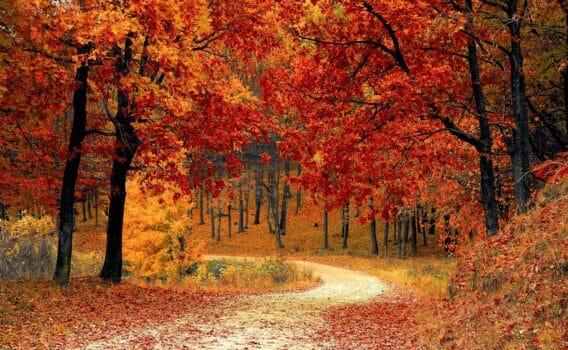
Although there are thousands of species of trees found worldwide, there are two main types of trees you should know about. These are:
-
Deciduous Trees
These trees are more commonly known as hardwood trees. They are known to shed their leaves annually, typically during the fall season. What makes them special is that they are all unique!
Deciduous trees come in a variety of shapes, with leaves in various colors, patterns, and sizes. Depending on their species, these leaves may be oval, heart-shaped, or even star-shaped.
-
Coniferous Trees
These trees are different from Deciduous trees in one main aspect – they are evergreen. Coniferous trees remain green all year round, despite the ever-changing seasons and weather. The leaves of coniferous trees are typically needle-shaped.
Tree Types
-
Arborvitae
The Arborvitae (Thuja occidentalis) is a native American tree that is lush and evergreen. It grows up to 40 feet tall and has a spread of 10-15 feet. They are often used as accents in lawns and gardens and are incredibly robust even in cold, harsh climates. It has the capacity to tolerate poor soil, wet ground, and cold weather.

Arborvitae thrives in both complete sunlight and light shade and grows anywhere where the soil isn’t too dry. With an attractive, upright, and lush form, they are a popular addition to any lawn.
-
Black Willow
The Salix nigra, commonly known as the Black Willow, is a member of the Willow family. These trees are typically small to medium-sized and can grow up to 60 feet high. A well-known characteristic of the Black Willow is its ability to thrive in wet, even swampy conditions.
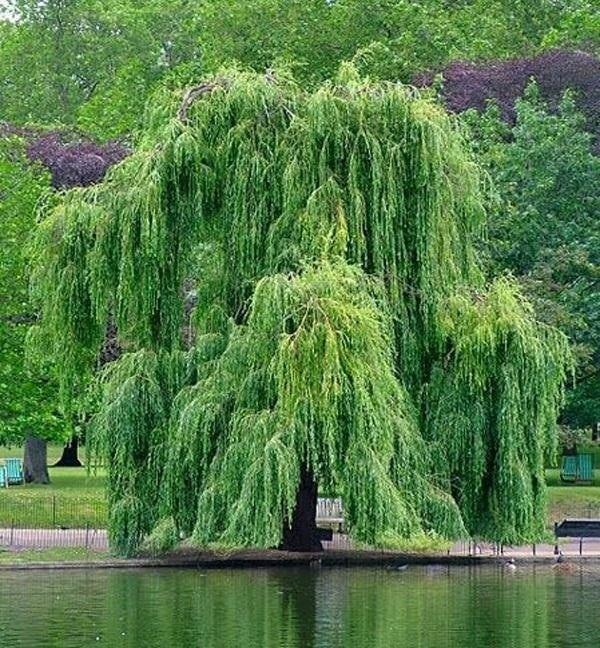
The leaves of the Black Willow are narrow and tapered, growing up to 6 inches long. Although these trees prefer wet or moist soils, like the ones found near streams, they also grow on fresh, sandy, and gravelly soils. The trees’ parts are commonly used for pulp, boxes, and even for artificial limbs, owing to their inherent lightness.
-
Black Ash
The Black Ash is also known as Fraxinus nigra, and are typically found in the northern swamp woodlands of America and Eastern Canada. However, you will also find a lesser-known species of the Black Ash in parts of Asia.
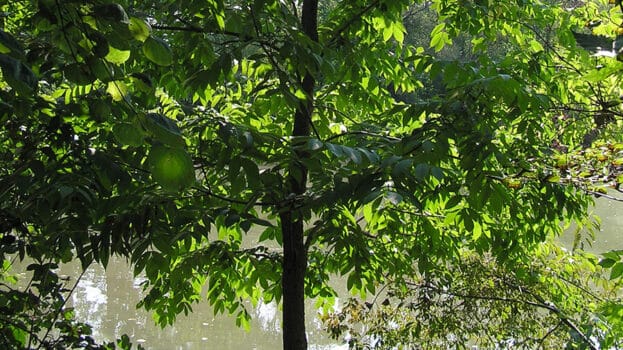
The tree’s bark is quite tough, heavy, and grainy in texture. Even so, the bark is soft, ash-colored, and relatively thin. A curious characteristic of the Black Ash leaves is that they don’t have a stem. The wood of these trees has several uses, such as in the making of baskets, bottoms of chairs, and hoops.
-
Black Walnut
The Black Walnut tree is native to some parts of New York state and is valuable for its timber. Also known as the Juglans nigra Linnaeus, this tree is famous for its large-sized edible nuts and its highly-prized wood.

When found naturally, the Black Walnut can grow up to 75′ tall, but these trees grow to 150′ tall in plantations and forests. They have well-formed trunks and limbs, and the crown of these trees are typically open, round and have low branches. Their crowns are often spread out, reaching out to be wide as they are tall.
However, their roots release a substance known as juglone, which is toxic to other juglone-sensitive species.
-
White Ash
The White Ash tree (Fraxinus Americana) is commonly found around the woodlots of New York, and is known to be one of the fastest-growing trees, reaching altitudes of 2,000 feet. You will typically find them growing in abandoned agricultural lands and moist, rich soils.
Wood from White Ash trees is very robust, durable, heavy, and tough-grained. This is why they are used for making furniture, sporting goods, tool handles, oars, and other types of agricultural implements.
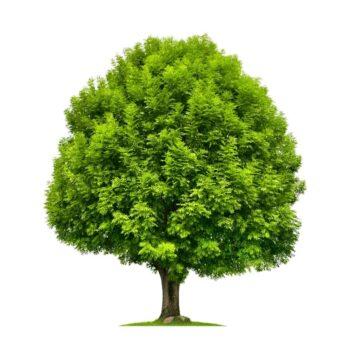
Coming to the bark of the tree, it is rich and has a brownish-grey tinge. The stems and twigs are the same, but flat-shaped. Their leaves have several smaller leaflets and grow in clusters.
-
Tulip
Liriodendron tulipifera Linnaeus, which is the scientific name for Tulip trees, is a fast-growing tree with bright leaves. It is one of the most attractive trees and bears large, tulip-like flowers which are greenish-yellow in color. The leaves are also brightly green, but they turn golden yellow during the fall.
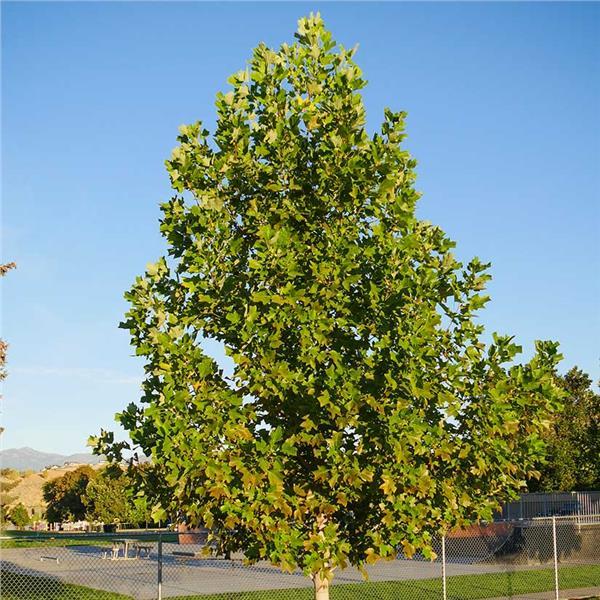
The stems are highly aromatic; however, they are most commonly known for the brightly colored flowers. The wood of this tree is quite soft and brittle, lightweight, and straight-grained. Due to these characteristics, the soft wood is often used in interior finish and lumber.
-
Neem
The Neem tree is a vastly popular tree found in south and southeast Asia. Its scientific name is Azadirachta indica. In Asia, the neem tree is considered a household staple and has a variety of uses. In fact, one of the best things about the neem tree is that every part of it is useful in some form or the other.
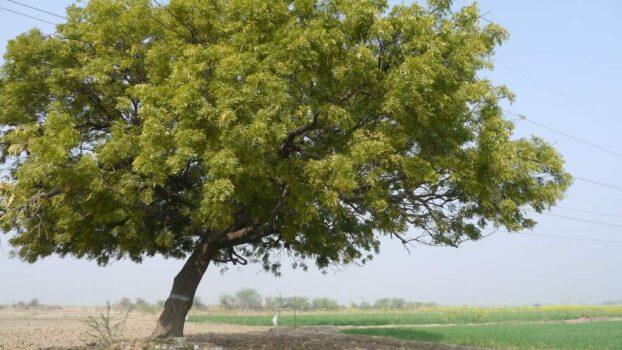
The wood of neem trees is commonly used for making furniture, and the leaves, stems, and other twigs of the tree have immense medicinal properties and benefits. They are also used in fertilizers and have inherent anti-bacterial and anti-fungal properties.
-
Apple
Apple trees are all too famous for their delicious, round, tasty fruits. These trees are also known as Malus x domestica, and people have bred the trees for centuries for various purposes. While the apples themselves are often sold as a whole, they are also used to make other products like apple juice, cider, etc.
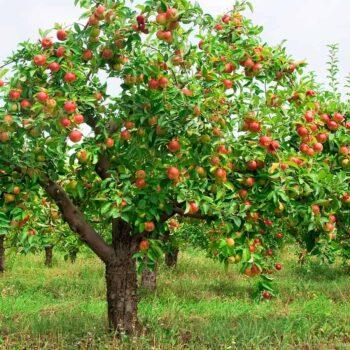
The leaves of apple trees are dense green and oval-shaped. The underside of these leaves is curiously furry or woolly. Its flowers are beautiful, five-petaled white blooms with hints of pink. Typically grown in clusters known as blooms, apple trees grow in all temperate zones around the world.
-
Crab Apple
The apple tree has more than 6,000 varieties, the Crab Apple Tree being one of its ancestors. Although they are often confused with Apple Trees, these trees are quite distinct in their appearance and fruits.
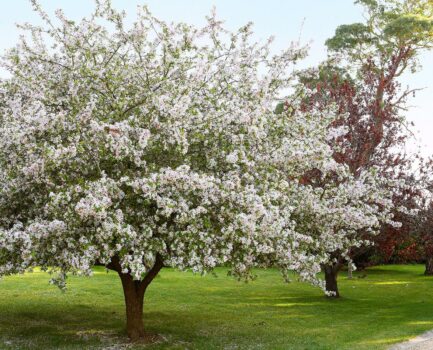
The Crab Apple Tree can grow for about 100 years and reach a height of 10 meters. They typically have an irregular, rounded shape and the twigs, when allowed to grow naturally, often get twisted and gnarled amongst themselves. This gives them a ‘crabbed’ appearance, which is where the name ‘Crab Apple’ tree comes from.
Fruits are typically green in color, with red or white spots when ripe.
-
Bigtooth Aspen
With a curious name like ‘Bigtooth Aspen,’ the trees are popular due to their distinct features and large, tooth-like leaves. These are typically short-lived trees of the deciduous kind. They are known to grow fast and thrive in deep, moist soil. However, they can also grow well in drylands, where they are often prone to burning.
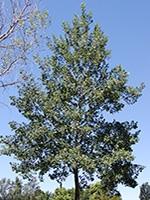
It’s worth mentioning that the Bigtooth Aspen’s bark is similar to that of the quaking Aspen. The difference lies in their branches, which are yellow in color, and the smaller, teeth-like leaves of the quaking Aspen. Their barks are thin, white, and smooth, and they can grow up to 60 feet.
-
Quaking Aspen
The Quaking Aspen, also known as Populus tremuloides, has a curious name that fits right into its personality. This tree is native to New York and found abundantly around various areas of it. This tree’s quirky trait is that it can quickly establish itself in all kinds of areas, even old, abandoned fields.
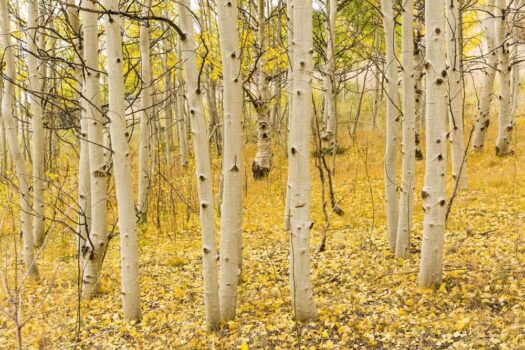
Its funny name comes from the fact that the leaves of the tree start shaking vigorously, causing a ‘quaking’ sound, even when the lightest breeze happens to hit it. It so happens that the wood of the Quaking Aspen is light, soft, and not at all durable. It is used for boxes, crates, excelsior, and pulp.
-
Sycamore
The Platanus occidentalis Linnaeus, more commonly known as the American Sycamore Tree, is a large, fast-growing tree found abundantly around fertile, moist soils. These trees are considered to be ideal street trees, owing to their ability to provide shade and tolerate large amounts of pollution and salt.
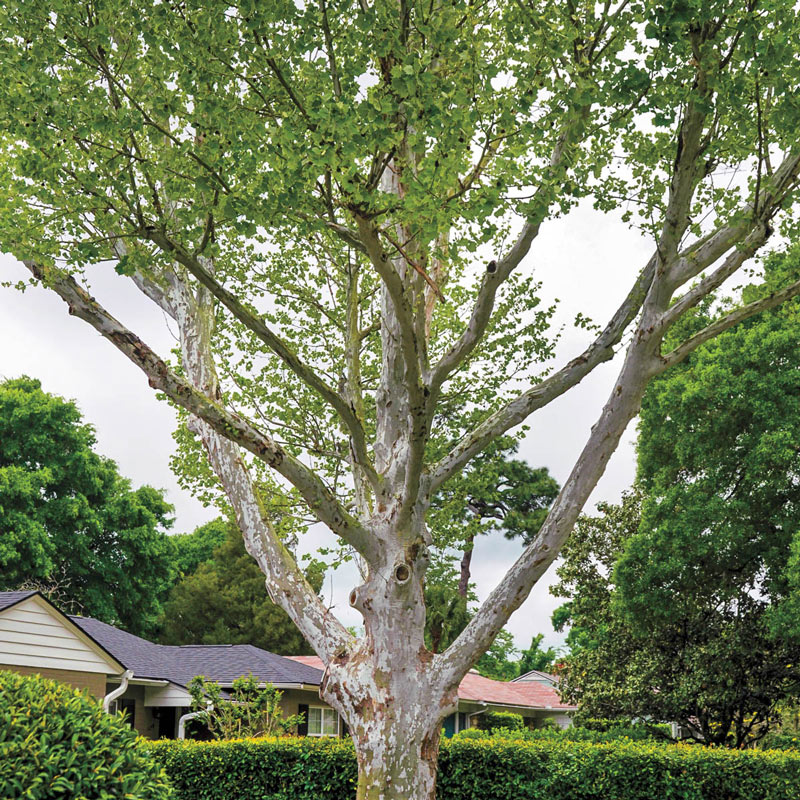
These trees grow massive – up to 6 feet in just a year. Their wood is heavy, hard-grained, and tough but not strong. It’s used to make tobacco boxes, novelties, butchers’ blocks, and interior woodwork.
-
Mahogany
The Mahogany tree (Swietenia mahagoni) is a ubiquitous tree found mostly around regions of Southern Florida. However, it is also commonly found in other areas of Southern Asia and the Caribbean islands. The tree is known for its thick, sturdy trunk, which has a rich, brown color. The hints and flecks of light brown add to its wood’s appeal, making it popular in the making of boats, furniture, musical instruments, and caskets.
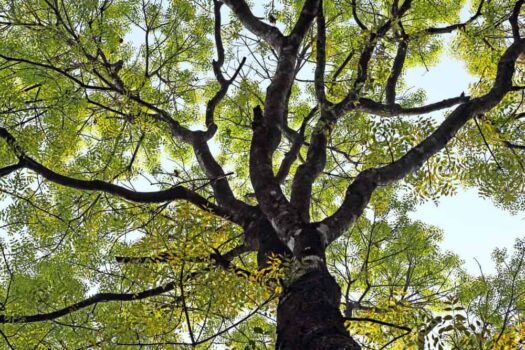
The bark of the Mahogany tree is gray and has a smooth texture. However, with age, the color gets darker. Its bark has medicinal properties and is used as an astringent and for treating dysentery, fever, and anemia.
-
American Beech
Native to the Eastern United States and the Southeast parts of Canada, the American Beech ( Fagus grandifolia) is a large-sized deciduous tree. Although the tree is abundantly found around various regions of North America, the tree’s wood is not very valuable.
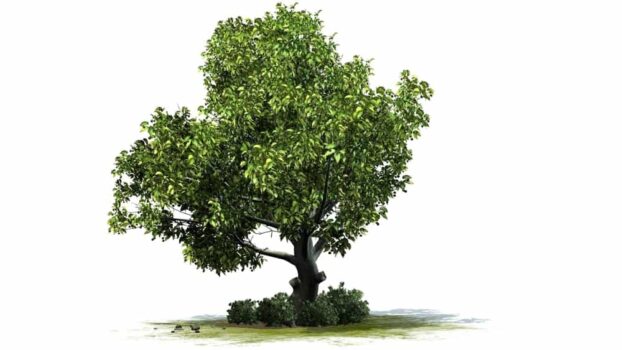
However, the wood is tough, solid, and heavy, making it perfect for fuelwood. The wood is also commonly used in the acid wood industry for making furniture, baskets, and crates. The leaves have teeth along its margins, similar to apple tree leaves, and dark rich, dark green.
-
Gray Birch
The Betula populifolia or Gray Birch is yet another fast-growing, medium-sized deciduous tree. Native to North America, you will find this species growing abundantly in New Jersey, Pennsylvania, and even some parts of Ontario.
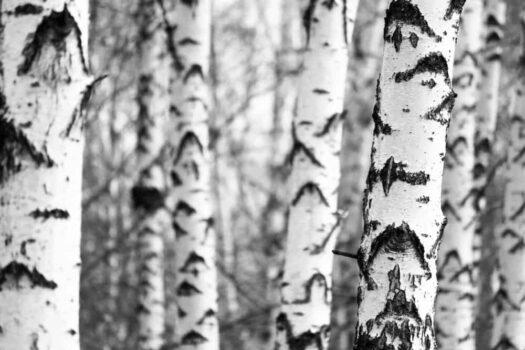
The Gray Birch is often confused with its sibling, the paper birch tree. However, the Gray Birch is neither as valuable nor as big as its sibling. The bark of the Gray Birch is similar to the Aspen, but most tree lovers agree that the Birch has a more attractive thin, tall and colored bark.
-
Paper Birch
Although the Paper Birch (Betula papyrifera) is a fast-growing tree, it has a short life. This tree gets its name from its trunk characteristics – thin, white, and peels off its body like paper. Even though the Paper Birch can grow quickly in all kinds of soil, it is intolerant to shade and requires a heavy dose of regular sunlight.
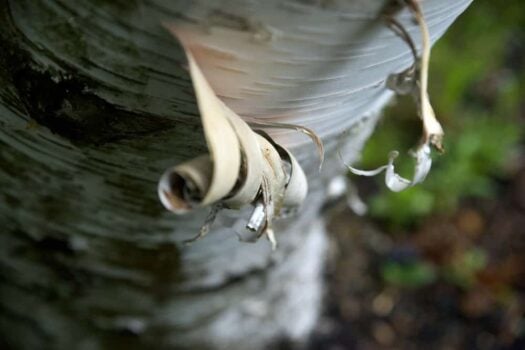
As for the soil, this tree requires moist, swampy soil and grows best beside rivers, streams, lakes, and swamps. With tough, hard, but light wood, the tree is commonly used for making woodenware, shoe lasts, wood pulp, and spools.
-
Black Birch
Coming from the same family as the other Birch’s, the Black Birch, or Betula lenta, is a native North American tree. Its leaves are simple, pointed, and don’t have any distinct features. However, the wood of the Black Birch is coarse-grained, stiff, strong, and heavy. It is used in the making of furniture and fuel.
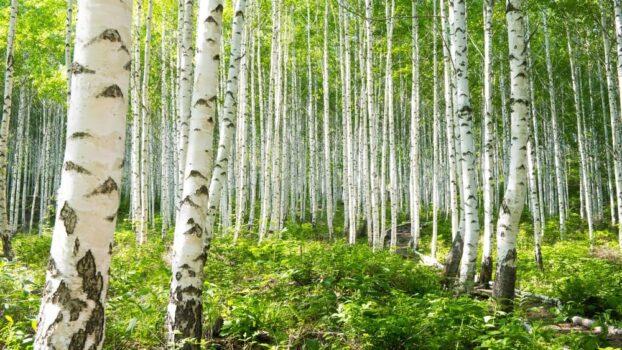
In addition to that, Black Birch is often used as a substitute for more expensive woods, such as Mahogany and cherry. The twigs are often used to make oil extracts that have medicinal properties.
-
Yellow Birch
Native to northeastern North America, the Yellow Birch, or Betula alleghaniensis, is a medium-sized deciduous tree. This tree is seen to flourish when it grows alongside beech and sugar maple trees. They thrive together on moist, rich uplands and grow quite quickly.
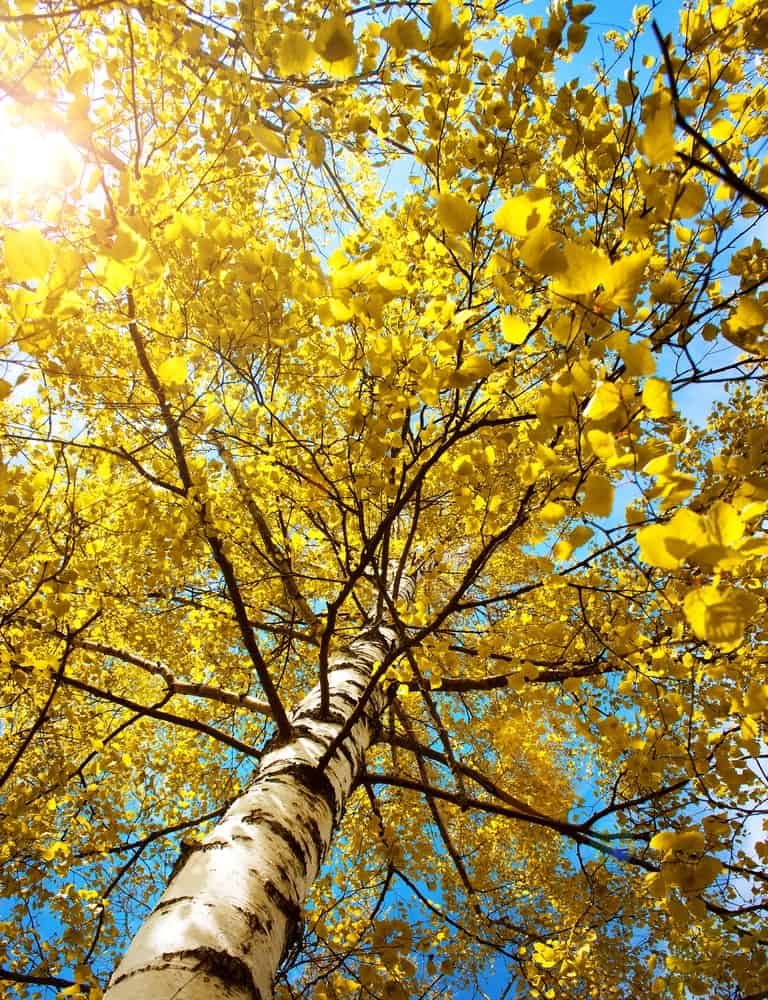
With light-brown colored coarse, hard wood, it is often used as fuelwood by farmers. However, it is also used in flooring, lumbar, woodenware, furniture airplanes, interior design, and even agriculture.
Its unique characteristic is its bark, which is bright, yellowish silver in color when young, but begins to peel off as it ages. After this, the bark turns into a dark, brownish-red.
-
Pin Cherry
As the name suggests, the Pin Cherry tree, also known as the Prunus pensylvanica, is a small cherry tree. Due to its size, it is often considered a shrub. Native to North America, the Pin Cherry is typically found in provinces of Canada.
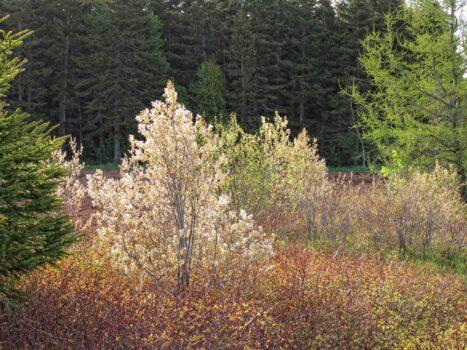
The unique aspect of this tree is that it thrives in abandoned lands. Owing to this quality, trees are planted abundantly around wastelands, where they grow and thrive. This protects the soil of the wasteland and also allows the trees to flourish to their full potential.
-
Black Cherry
Unlike the Pin Cherry, the Black Cherry tree is medium-sized, fast-growing, and found around North and South America. However, this tree is also considered a shrub because of its small size. Its scientific name is Prunus serotina.
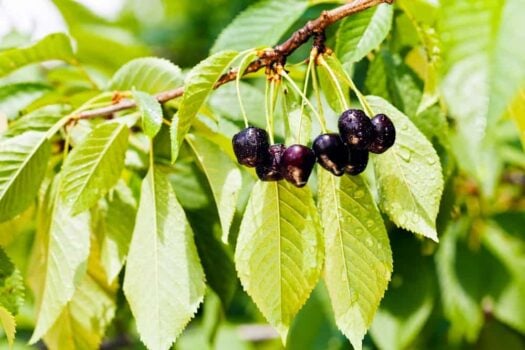
These trees thrive in moist hillsides and rich, soiled bottomlands, but they can also grow well in dry soils. The wood of these trees is invaluable and always in high demand. Its strong but light, pale, brownish-red wood is commonly used for cabinet making, interior design, fence posts, tools, and tires. Apart from this, their timber is a rich source of nutrition for many wildlife creatures.
-
Butternut
Native to the eastern US and southeast Canada, the Butternut, or Juglans cinerea, is a slow-growing deciduous tree. The branches of the Butternut are said to grow long and freely. Its wood and edible nuts are what the Butternut is most famous for.
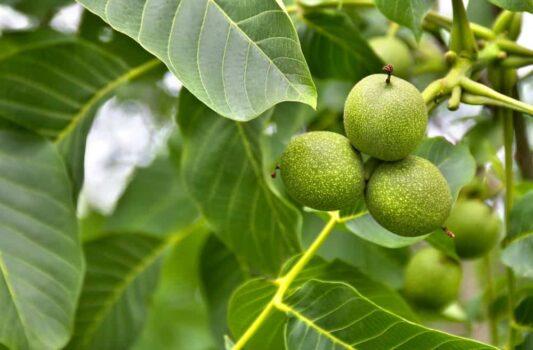
Although the tree grows best in moist, damp soil, you will find them growing on roads and alongside fences. Its wood is light, coarse, and durable, but not very strong. The wood is typically used in the making of furniture, interior, and fence posts. However, it’s important to stay safe around them because many of these trees are infected with canker diseases.
-
American Chestnut
The Castanea dentata or American Chestnut is native to North America, as its name suggests. This is a fast-growing deciduous tree, which is a subspecies of the Chestnut tree. Its other species are typically found in Japan, China, and some parts of Europe.
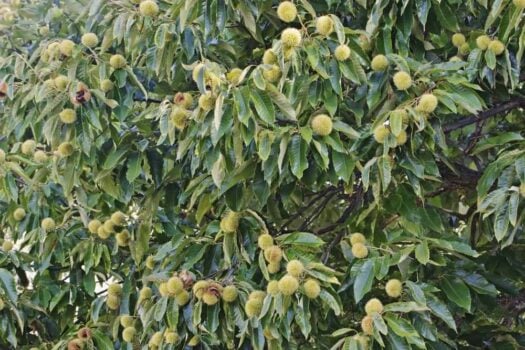
Since the wood of the American Chestnut grows very rapidly, it’s used abundantly by farmers. The wood is soft and light and is commonly used for making posts. Its leaves are similar to other chestnut trees’ leaves – small, oval, and light brown.
-
Eastern Cottonwood
The Eastern Cottonwood, also known as Populus deltoides, is a fast-growing but short-lived deciduous tree native to Mexico, Canada, and the United States. This tree thrives in moist, rich soils along streams and lakes. However, it can also be planted anywhere else where it will flourish – except at high elevations.
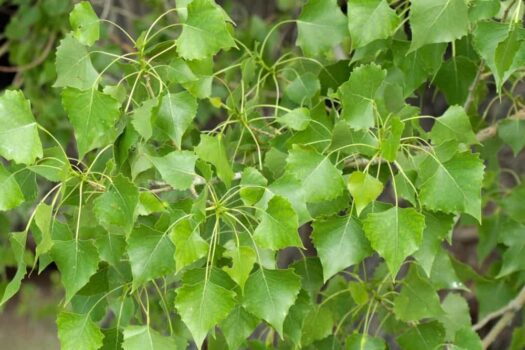
These trees are commonly used as ornamental pieces because of how attractive and appealing they look. That being said, they are known to clog drains and sewers, so one has to be careful when planting them.
Its bark appears smooth and light green, but it turns into an ashy gray, rough textured one as it ages.
-
Elm
A unique trait of the Elm tree is that they can be either deciduous or semi-deciduous trees. The Elm is also known as the Ulmus, is native to North America and Eurasia. These trees grow all around the globe and are most commonly used for ornamental purposes.
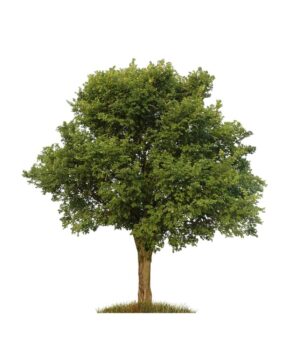
It’s fascinating to learn that the Elm has about 40 species under it, while are scattered worldwide. However, most of the species of Elm are similar in their looks and characteristics – with simple leaf shapes and a strong trunk.
-
American Elm
The Ulmus americana, or American Elm, as the name suggests, is native to North America. This tree is known for its graceful appearance and is found growing abundantly in the bottomlands. Its wood has a particular light brown color, which is very attractive. It is heavy, coarse-grained, strong, and very hard, typically used to make barrel staves, crates, veneer, and wheel hubs.
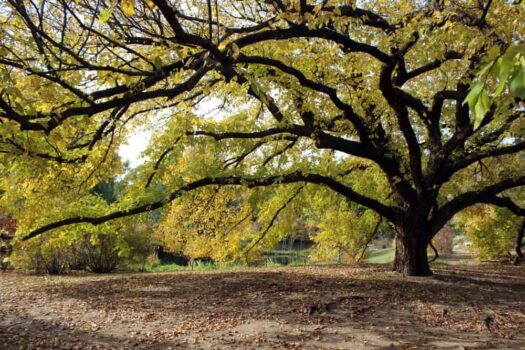
However, the tree became victim to the Dutch Elm disease and could no longer be seen growing in parks and streets. Concerted efforts have been made to revive its species.
-
Slippery Elm
The name ‘Slippery Elm’ comes from its inner bark, which excretes a white, glue-like slimy substance. The Slippery Elm is also called Ulmus rubra and is found in many areas of Texas, Florida, Quebec, North Dakota, and Maine.
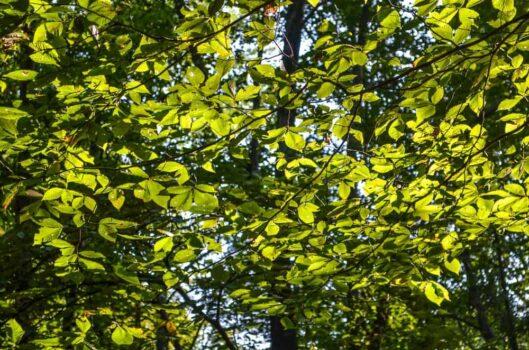
It thrives along low, fertile slopes along banks, and its strong, hard wood is typically used in making ties, hoops, fence posts, and barrel staves. Their large, green leaves have teeth-like margins and change color as they mature.
-
English Elm
This tree has several names; the English Elm, British Elm, or its scientific name – Ulmus minor ‘Atinia.’ Central southern European fields would be filled with these flourishing trees before the Dutch Elm disease destroyed them.
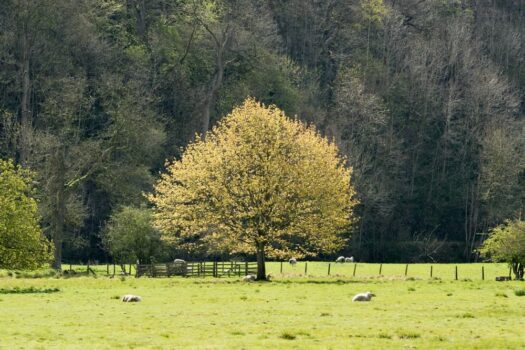
With thick, dense wood, the English Elm is often used for making lock hates, furniture, timber, and even in the construction of jets. Its leaves, like the Slippery Elm, are light green but darken as they age.
-
White Spruce
The White Spruce, also called Picea glauca or Cat Spruce, is found only in the Adirondacks. Although its appearance and foliage make it a popular ornamental tree, especially as Christmas trees, its wood is even more famous for chemical pulp.
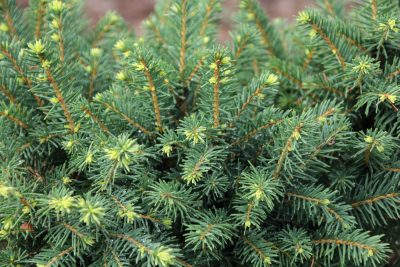
Its smooth, slender twigs give it a distinct appearance and have needle-like leaves that change color throughout its life. Moreover, its twigs have a distinctive, strong odor when they are crushed.
-
Red Spruce
The Red Spruce is a precious tree native to the Adirondacks and Catskills. Also known as the Picea rubens, the tree is found at high elevations in parts of eastern New York as well. Its wood is light and soft, often used for chemical pulp.
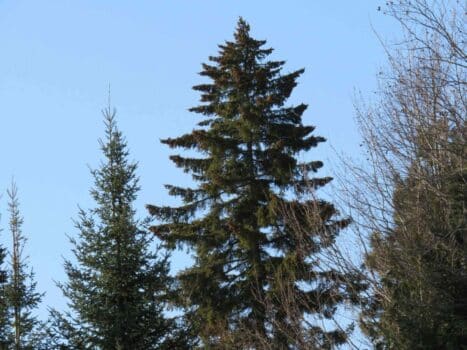
However, it is most commonly used to make musical instruments due to their distinct resonant qualities. It gets its name ‘Red Spruce’ due to its needle-like leaves and a thin, reddish-brown bark and twigs.
-
Bitternut Hickory
The Carya cordiformis or Bitternut Hickory is a large-sized deciduous tree found abundantly around North America. It thrives in wet, rich soils such as on pastures, along streams, on ridgetops and hillsides.

Its wood is commonly used for pulpwood and lumber, as it is robust, heavy, and hard. The leaves come in a variety of sizes but taper sharply at the top. It is a distinctive light gray bark with furrows all over it.
-
Shagbark Hickory
The Carya ovata or Shagbark Hickory is the most well-known and valuable Hickory tree amongst its species. It is large and long-lived, found densely around the northeast United States and South East Canada.
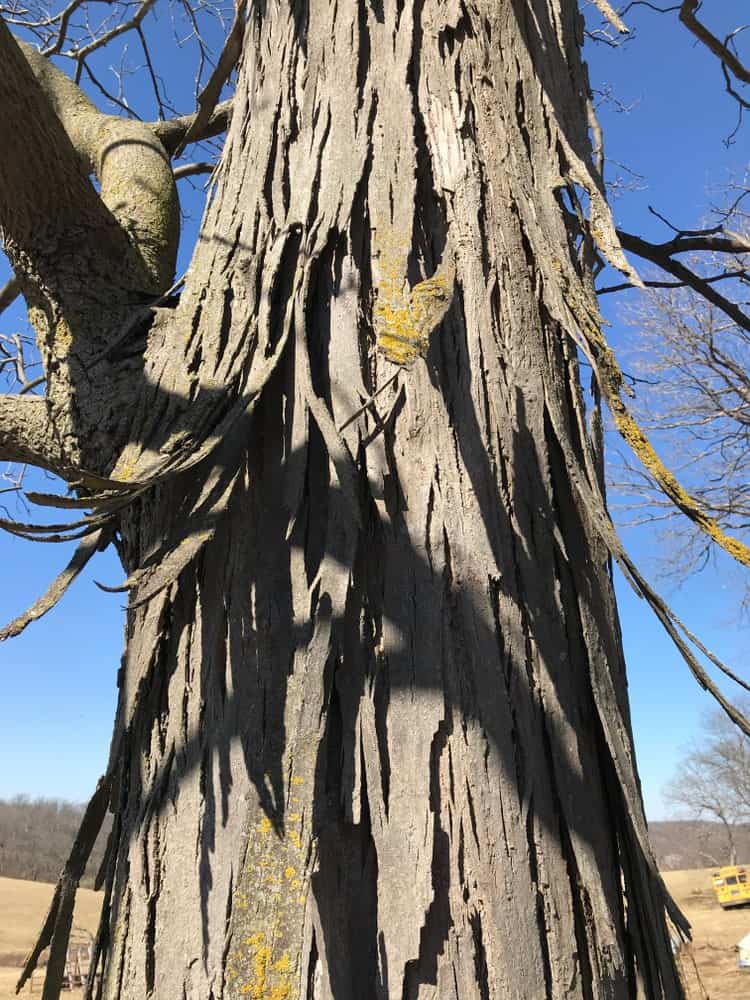
The tree gets its peculiar name due to its long, gray bark, which peels off in long strips as it matures. Its peels have loose ends but are attached at the middle and top, giving them a ‘shag-like’ appearance.
-
Pignut Hickory
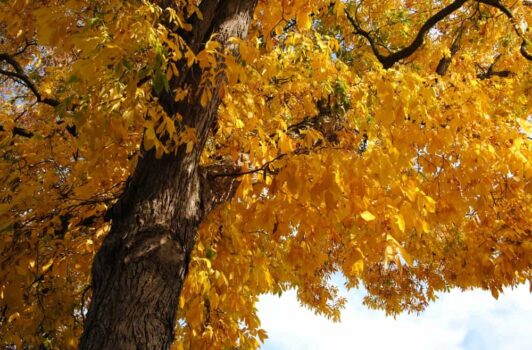
Also known as the Carya glabra, the Pignut Hickory is yet another species of the Hickory tree. It is medium-sized with beautiful, bright yellow leaves and tough, robust wood. Commonly found around Eastern US and Canada, this tree isn’t extensively used for commercial purposes. Its bark is similar to the Bitternut Hickory – gray with shallow furrows over its body.
-
Eastern Hemlock
The Eastern Hemlock or Tsuga Canadensis has an attractive appearance, with beautiful, dark green leaves and a gray-red bark. Its wood is relatively soft and brittle, coarse-grained, and not durable. This is why the wood is commonly used in construction limber and also used for pulp.
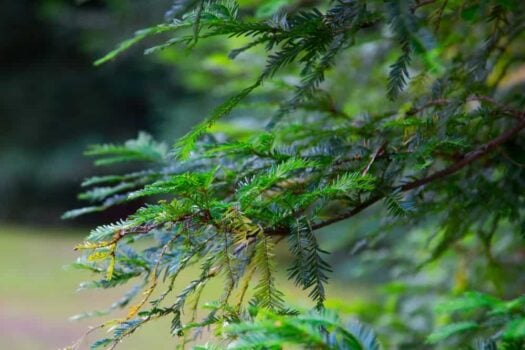
The tree is commonly found around North America and is considered valuable. It thrives in shaded areas like swamps and steep mountain slopes.
-
Balsam Fir
The Balsam Fir, also called Abies balsamea, is a medium-sized evergreen forest tree found abundantly around eastern and central Canada as well as the northeast United States. This tree is most commonly known for its use as a Christmas Tree.
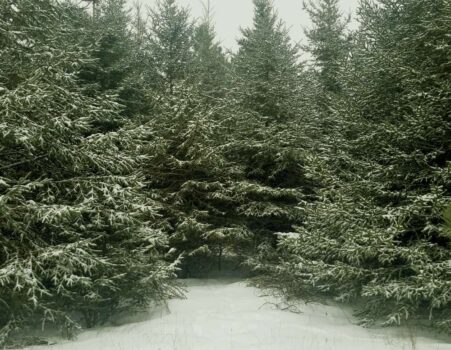
With a gray and brown bark, and twisted, needle-like leaves, it has a strong scent that is emitted when it is crushed. Moreover, its body is covered with small patches of balsam blisters containing an oily resin.
-
Hawthorn
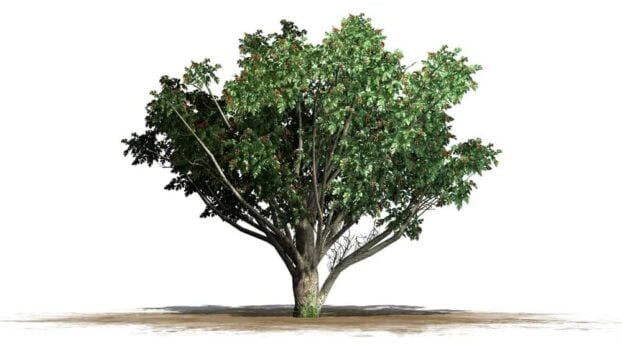
The Hawthorn trees or Crataegus are small, gray, or brown trees with a distinctive shape and structure. Its bark is scaly, and owing to its small size, the tree cannot be used for commercial purposes. However, its most distinguishing factor is the beautiful fruits and flowers which the tree bears. It is found in North America, Europe, and Asia.
-
American Hophornbeam
The Ostrya virginiana or American Hophornbeam has a peculiar name that sparks the curiosity of most tree lovers. It is a small-sized deciduous found mainly in parts of Mexico, North and Central America.
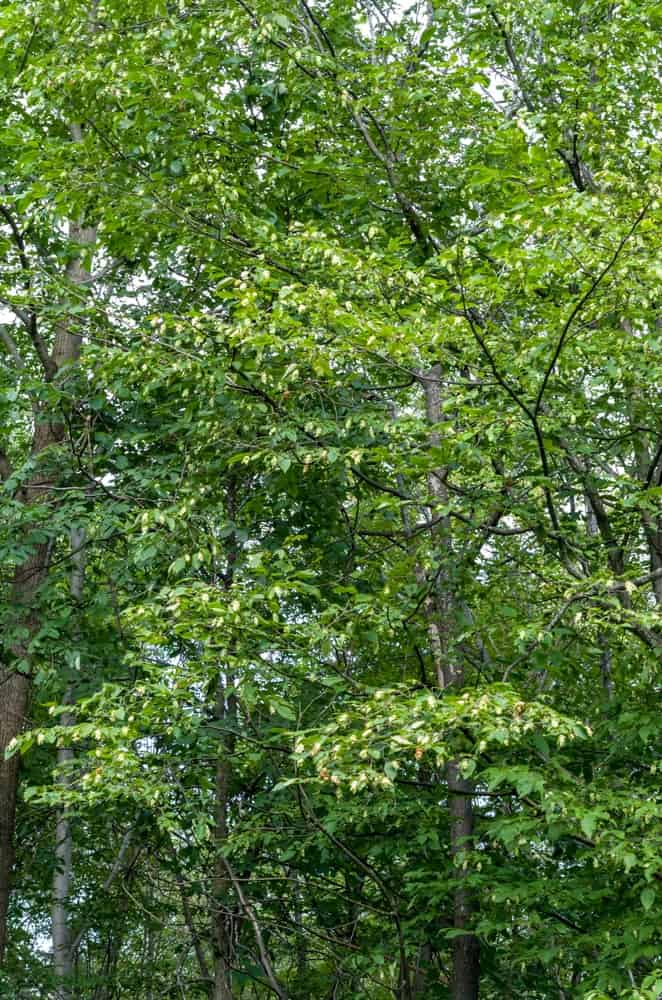
The tree is extremely slow-growing and never reaches more than 10 inches in diameter. However, its wood is strong, hard, and heavy and is used commonly for ironwood.
-
American Hornbeam
Carpinus caroliniana or the American Hornbeam is small, bushy, and has a distinctive dark blue-gray bark. The bark is relatively smooth when it is young but becomes rough as it grows older.
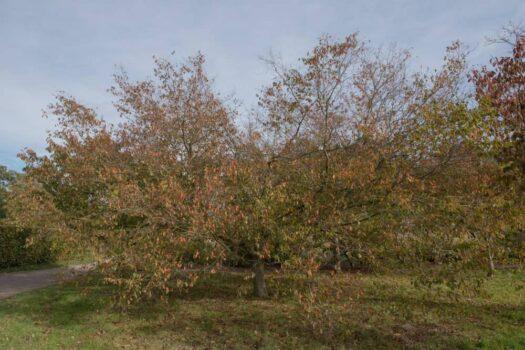
Like the previous tree on the list, this one also remains small throughout its life, its diameter remaining just 6 inches. Its wood is typically used for mallets due to its hardy and robust nature.
-
Black Locust
Robinia pseudoacacia, or the Black Locust tree, was first planted in the eastern United States. However, over generations, the tree has spread over other parts of the world, including India, South Africa, New Zealand, South America, Europe, etc.
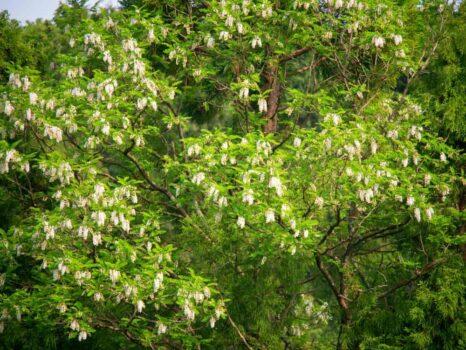
It thrives in drained, rich soils and in open locations where it can freely spread its roots. The wood of this tree is very precious and often used for ties and fuelwood.
-
American Larch
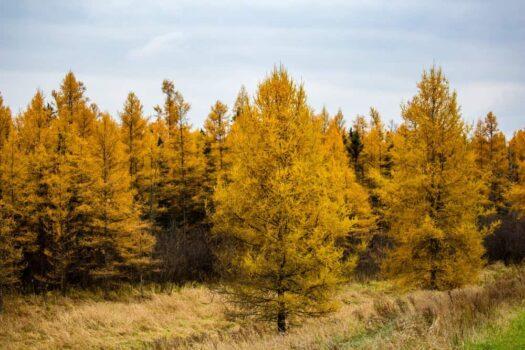
The Larix laricina or American Larch can grow anywhere between small to medium-sized. They are boreal deciduous as well as coniferous trees and are found vastly around Canada. Its wood is hard, strong, heavy, and has a pure light brown color. Being extremely robust and durable, it’s often used for making telegraph poles, fence posts, and railroad ties.
-
Shadbush
The Shadbush is an extremely attractive and appealing tree which is small-sized with tiny, white flowers. It has a smooth, gray-brown bark, often marked with long streaks, denoting its age.
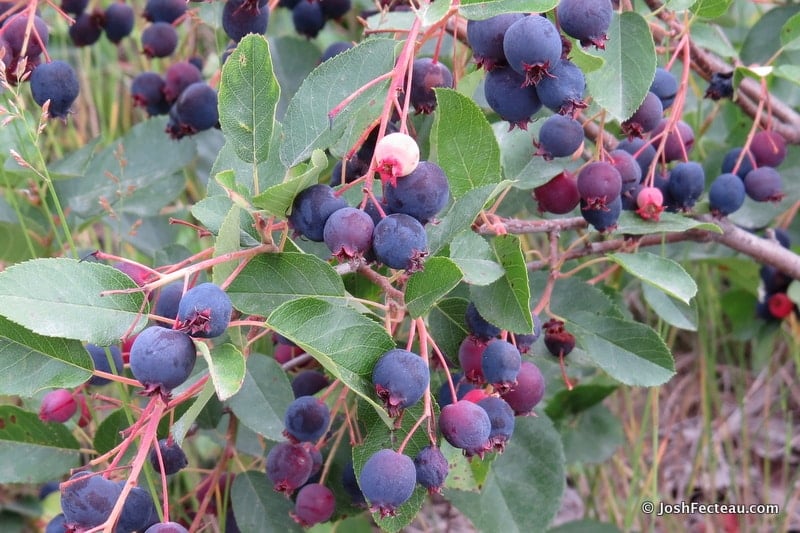
The tree bears sweet berries that have a reddish-purple color and are a popular food for birds. Its finely serrated leaves are small but sharply pointed.
-
Dogwood
Arguably one of the most beautiful, ornamental trees, the Dogwood is a small-sized deciduous which blooms gorgeous white and yellow flowers during spring. This tree thrives when it gets adequate amounts of water and sunshine.
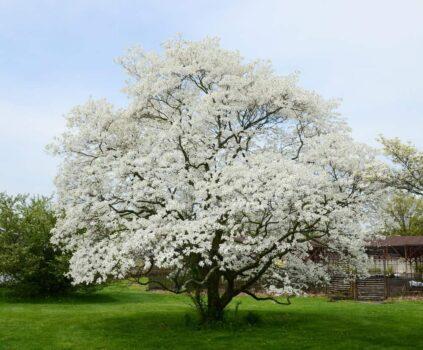
Its wood is gray, coarse-grained, and hard, often used for making mallets, golf club heads, butcher blocks, and jewelry boxes. Due to its dense nature, it is also used in making tool handles and wooden rake teeth.
The bark has a unique, gray, and scaly appearance with an ash-brown color. During the fall, the leaves turn a brown-red color, which gives it a distinguished appeal.
-
Eucalyptus
Eucalyptus is a commonly known species that has over 700 variants – from shrubs to flowers and trees. Although most of these species have different names, they are widely known as eucalypt in European nations.
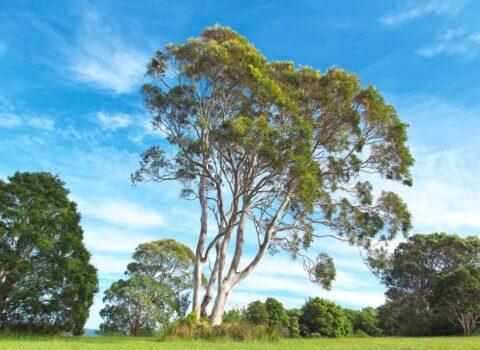
These trees or shrubs typically have a hard, stringy, and smooth bark and leaves with oil glands. They also have petals and sepals, along with a fruit that is known as the gumnut. This fruit is shaped like a wooden capsule.
Eucalyptus is native to Australia and thus able to withstand wildfires. They regenerate very quickly and are fast-growing. Its timber is used for honey, pulp, and essential oils.
-
Sassafras
The Sassafras albidum, or simply – Sassafras, is typically a small to medium-sized tree. Being completely shade intolerant, it’s important to remember to plant these trees only in areas where they get abundant sunlight. Typically, they flourish when they receive at least 6 hours of sunlight per day.

The plant has a deep taproot, making it easy to grow them from small saplings rather than seeds. It has a reddish-brown bark with deep furrows, even when the trees are young and small. Moreover, it has a variety of leaf shapes on every individual tree, which is a fascinating trait.
-
Eastern Red Cedar
The Eastern Red Cedar or Juniperus virginiana is a fascinating, small-sized coniferous tree native to Central and North America. This tree is slow-growing and typically doesn’t grow to be taller than a bush. It is usually planted around dry or low-quality soils.

However, when they are planted in the open with an abundance of sunlight, they thrive and grow quite large. As the name suggests, this tree’s wood is red with highlights of sapwood. It’s commonly used to make pencils, cedar chests, interior decoration, and cabinet works.
-
Scots Pine
The Scots Pine (Pinus sylvestris) is also called the Scotch Pine in some areas. It is a medium to large-sized coniferous tree, evergreen and commonly used as a Christmas tree. Commonly found around Asia and Europe, this tree grows well when planted in poorer quality soils, like sandy, dry areas, near peat bogs, or along the outer limit of forests.
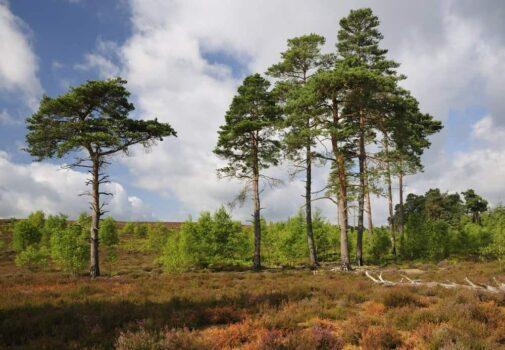
Its wood is thick, coarse-grained, and brown, often used for pulpwood, ties, and framing lumber. The bark, however, is gray-brown and often scaly. Funnily, the needle-like leaves have a peculiar blue-green color.
-
Eastern White Pine
The Eastern White Pine, also known as Pinus strobes, is found abundantly in the United Kingdom and North America regions. It is a medium-sized deciduous which thrives when growing along swamps, hillsides, and open locations. The wood of the Eastern White Pine is light-brown and soft, and very easy to work with.
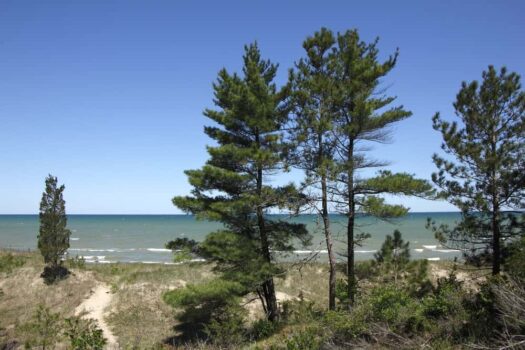
Typically, this tree’s lumber is used in the making of interior trims, buckets, boxes, doors, and sashes. In fact, it is the only tree whose wood is so versatile and functional. Although its leaves are needle-like, they are quite flexible.
-
Red Pine
The Pinus resinosa or Red Pine is a medium to large-sized, fast-growing evergreen tree. It is found vastly around the United States, the United Kingdom, and some parts of Europe. Although it is commonly planted in sandy soils, it also grows in other types of dry soil. The tree is in high demand due to its timber.

It gets its name from its wood, which is light red in color and very light and smooth. However, since the tree grows rapidly, it is prone to insect infestation and diseases. It’s due to this reason that the Red Pine is typically planted in areas far away from the human population.
-
Pitch Pine
The Pitch Pine (Pinus rigida) is small to medium-sized and is known for its tolerance to grow in conditions where other trees cannot survive. Found commonly in Europe and North America, this tree can grow in a variety of unsuitable conditions – like in acidic, sandy, or low nutrient soils. Moreover, it also grows well on slopes.
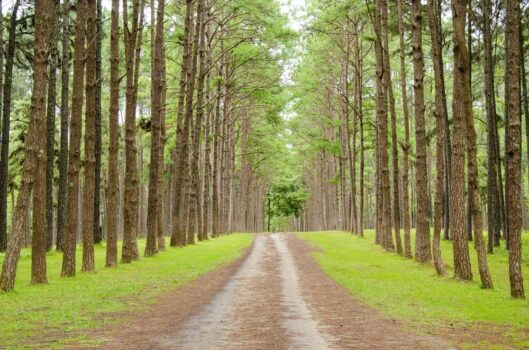
Its bark is reddish-brown in color and darkens as it ages. Due to its thickness, it is fire-resistant. A curious characteristic of the Pitch Pine is the clusters of needle-like structures located all over its trunk.
-
Black Oak
The Black Oak or Quercus velutina is found abundantly in many areas of North America, but it is not as valuable as its variation – the Red Oak. Black Oak is a medium-sized, fast-growing tree that grows well on dry and gravelly soils. Its wood is strong, hard, and durable and used for fuelwood, construction, and ties.
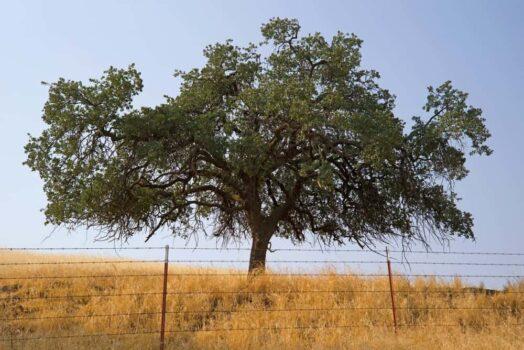
Although its bark starts off as dark brown, it becomes gray as it ages. Once in a while, the bark peels off to reveal a fascinating yellow-orange inner skin that can be used in the making of yellow dye.
-
Scarlet Oak
The Scarlet Oak, as its name suggests, is a vivid, scarlet tree that is native to the Central and Western United States. Owing to its bright, beautiful foliage, it is often used as an ornamental tree by homeowners and tree lovers.
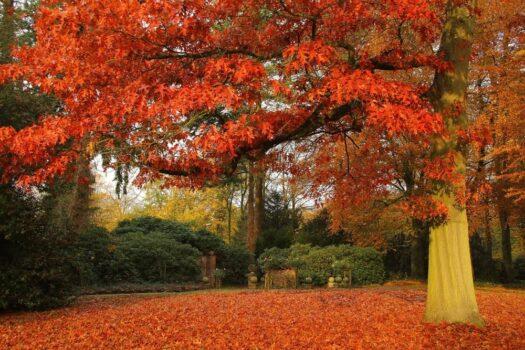
Its bark is light-brown in color and has a smooth texture. As it ages, it grows furrows along its body, which gives the entire tree a unique appearance. Moreover, its inner bark is of a beautiful, red shade.
-
Chestnut Oak
Also known as Quercus Montana, the Chestnut Oak is another species of the Oak tree native to the eastern United States. The reason behind its curious name is its chestnut shaped leaves. It is a medium-sized deciduous tree that is found on drylands, rocky hillsides, and ridges.

Its wood is similar to the White Oak, but not as valuable. The bark is yellow-brown in color and smooth when young, but gets darker and develops ridges and furrows as it ages.
-
White Oak
The Quercus alba or White Oak is a medium to large-sized deciduous, which has a white bark. It’s interesting to know that no other tree has an exotic looking white bark like this one, which is why it is quite popular. These trees grow well in moist as well as dry soils.
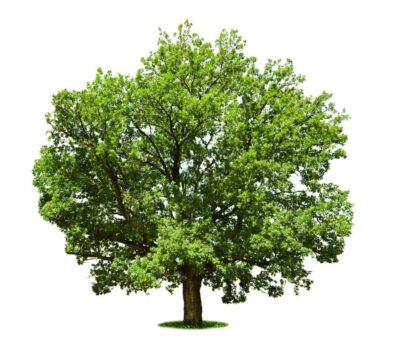
The wood of the White Oak is strong, hard, and durable, making it perfect for general construction, which requires sturdy wood. It is also used for implements, ties, and flooring. The tree grows acorns, which are beneficial to the wildlife around which it thrives.
-
Elder

The Elder Tree, also known as Sambucus nigra is found in many subtropical and temperate regions of the world. It is most commonly found in the UK, where it lives for about 60 years. Typically, it thrives in scrubs, wasteland, and woodlands. It is also found growing near rabbit warrants and badger setts, where the furry woodland creatures spread the tree’s seed via their droppings. This is how they come to grow in other areas around the forest.
-
Sugar Maple
The Acer saccharum or Sugar Maple is another tree popularly known for its bright, vivid foliage and brilliant aesthetics. Its name comes from the fact that these trees produce a rich maple syrup, which is sugary, sweet, and highly in demand.
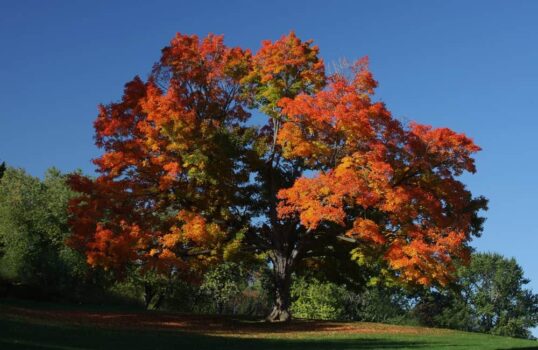
This tree is the state tree of New York, and along with its rich maple syrup, it is also known for its hard, thick wood. The wood is often used for making shoe boxes, in interior design, fuelwood, veneer, flooring, and much more.
-
Red Maple
Once again, the name gives away what this tree is famous for. The Acer rubrum or Red Maple has bright red leaves and is found around central and east North America. These trees grow well around swamps, woodlots, and areas with moist soil.

Its wood is coarse-grained and robust, but inexpensive. The wood it produces is used to make railroad ties, baskets and crates, fuelwood, and cheap furniture.
-
Silver Maple
The Silver Maple is native to the United States and Canada. It is a fast-growing medium-sized deciduous tree that is very similar to the red maple. It grows under the same circumstances as the Red Maple tree and also produces the same quality of wood.
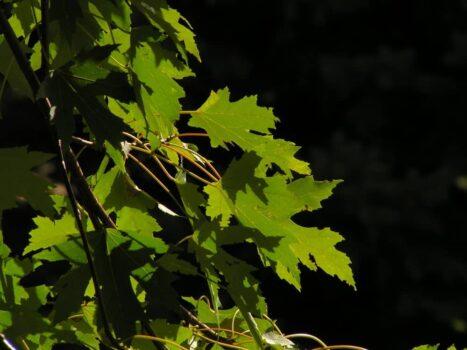
Because of its fast-growing nature, it is often planted as shade trees. However, it is relatively weak and thus should not be planted near buildings, cars, or homes.
-
Honey Locust
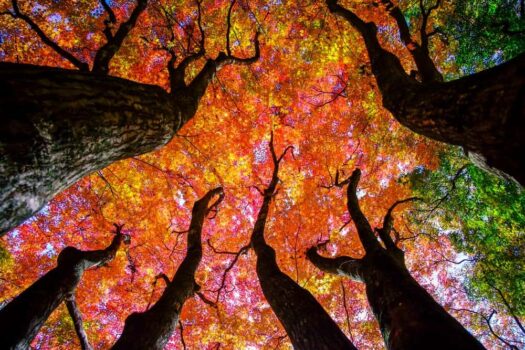
The Honey Locust or Gleditsia triacanthos is a medium-sized, fast-growing but short-lived deciduous tree found primarily in central North America. These trees are known for their adaptability to different conditions and are a highly invasive species. Its leaves are a subdued red, orange, and yellow color, which looks extremely attractive and thus is used as ornamental trees.
-
European Larch

As the name suggests, the European Larch is part of the Larch family of trees native to Europe. This is a mountainous, deciduous tree that is medium to large-sized and found only in cold, high, elevated areas. Typically found high in the Alps and the Carpathian Mountains, this tree has recently been spotted alongside parks and gardens where they are planted as ornamental pieces.
-
Douglas
The Douglas tree is most commonly used as a Christmas tree, but it has several other uses. It is an evergreen coniferous tree whose trunk has resin-filled, scented blisters.
The leaves are needle-like and flat and produce a sweet, resin smell when crushed. They are green in color with a white underside and develop oval cones once the female flowers are pollinated.
-
Guelder Rose

The Guelder Rose is an upright, deciduous shrub that reaches up to 4 meters high and can spread 2-5 meters. They have three-lobed leaves and distinct, creamy-white or pink flowers. Rings of larger, sterile flowers encircle each cluster of rose flowers. The tree bears red, translucent berries in autumn and are found commonly in low altitude regions around the UK.
-
Hazel
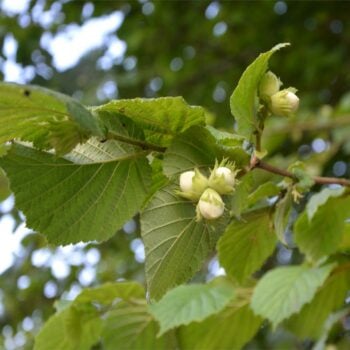
The Hazel tree is one of the most valuable and loved trees whose edible nuts are eaten by humans, squirrels, and other animals. These trees can grow for 80 years and reach heights of 12 meters. Its leaves are soft and have a particularly hairy underside. They can be round or oval-shaped with a pointed tip, which sheds during the autumn season.
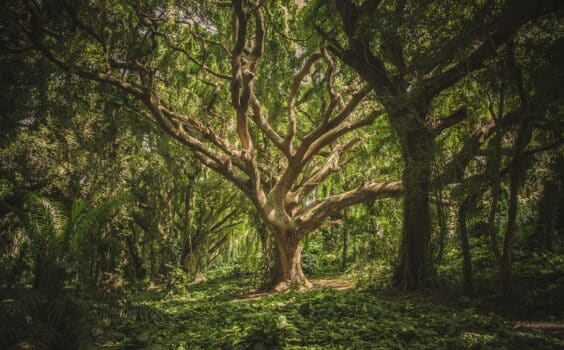
Final Words
We have listed 61 of the most popular trees for anyone who likes to read about them, plant them in their lawns, or just look at them. Trees give us life, and it’s worth your while to take some time out and learn more about them.
That being said, for tree lovers, there are thousands of more species you can explore, which are found all over the world. We hope you enjoyed going through our detailed list. Maybe you even have a few personal favorites.
Let us know what your favorite trees are and why you like them, or if you have a few more to add to our list! With that, we have come to the end of our comprehensive guide.
Keep learning about trees. Adios!
Related Links
Tree Diseased or Dead? | How Can I Tell & How to Save It
15 Best Plants to Grow for Privacy in the Backyard
31 of the Most Inspiring Japanese Zen Gardens in the World


